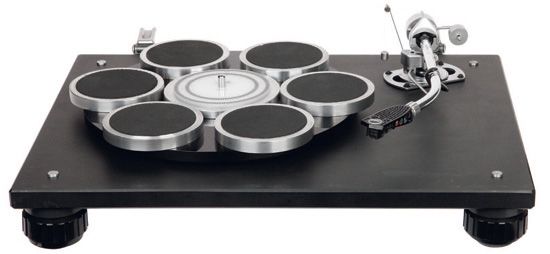It’s all forgotten now, but there was once upon a time when a costly – but not exorbitantly priced – turntable appeared, battled the best of the best, and triumphed. That is, almost. The JBE, you see, was an underground sensation for a brief period around the turn of the 1980s.
Despite its high quality, the deck never quite made it to the public. This was due in large part to the fact that its design and engineering were contrary to popular opinion at the time. First and foremost, it was a direct drive turntable, which was almost frowned upon in the United Kingdom. Most British hi-fi nerds of the time were enamored with the Linn Sondek LP12, believing it to be ideal and unrivalled. Although it was far less expensive when it first came out in 1973, the Linn was now highly pricey, costing roughly £350 plus arm. Most critics assumed that because it was “the best,” its belt drive mechanism would be outstanding as well…
The chassis design was also a challenge to tradition. It didn’t have any suspension, unlike the Linn, Ariston, STD, and Dunlop Systemdek, which were supposedly the greatest decks of the time. It did, however, have shock-absorbing Micro Seiki Microsorber feet. Instead, it depended on a massive piece of Welsh Slate as a base to dampen external vibrations. This was in stark contrast to the others, which all featured an independently sprung subchassis, which we were also told was superior. The cult of Linn made it difficult for any deck with ‘no’ suspension and direct drive to sustain audiophile pretensions.
JBE struggled to gain headway in the UK market, not least since the LP12 seemed to be worshipped by the major hi-fi journals. Because of their evangelistic enthusiasm, some even went so far as to suggest it in low-cost systems, completely out of context. As a result, the firm chose to participate in a three-way blind listening test. It was published in September 1979 and pitted the company’s latest Series 3 against a Linn LP12 and an STD 305M. SME Series III tonearms were installed on all three decks, and the makers set them up. The JBE was the least expensive, and many listeners said it was the winner.
Following that, the business was a resounding success. Some Linn dealers were enthusiastic about the instrument, but it was never going to be easy for them to promote it — or even sell it – when it delivered comparable performance for roughly three-quarters the price. Unfortunately, the company went out of business in 1982, taking the turntable with it. That year was a horrible year for vinyl, thanks to the introduction of Compact Disc, which effectively killed off a huge portion of the high-end vinyl market (don’t forget, CD players were initially quite expensive, and therefore direct price competitors to superdecks). A number of other turntable firms, including STD, were also shut down.
JBE decks are still fairly available these days – they’re never hard to come by. They’ve lasted because they were well-built. Because they don’t have springs, grommets, or belts, they can outlast their belt-drive rivals. The striking 6-disc, 1.9kg podule platter design – a black acrylic disc topped with six machined and balanced, foam-topped aluminium discs – was the most distinguishing feature, though the company offered a wide range of options, including a solid aluminium platter with rubber mat and rim-strobe if desired. The former had echoes of the Gale turntable and the Transcriptors (nee Michell) Reference Hydraulic and was similar but not identical to the Rega Planet (and its cheap spin-off, the Amstrad TP12D). It wasn’t perfect in terms of sound, but it gave the deck a startling, futuristic appearance, as if it came directly out of Gerry Anderson’s Space 1999 or Stanley Kubrick’s A Clockwork Orange.
A 24-slot, 8-pole stator, electronically controlled Matsushita direct drive motor was affixed to the plinth beneath the platter. The A-weighted rumble figure was 63dB, which wasn’t quite as good as the Linn or the Technics SP10, but it wasn’t far behind. The plinth, which was built (in the Series 3) from slate quarried in North Wales and was offered in two sizes, 435x335mm and 495x365mm, to suit the then-popular Dynavector DV505 tonearm, was another eye-catching element. The plinth was also available in clear and black acrylic. The majority of the instances came with a cut-out for a SME arm. Micro Seiki Microsorbers from Japan were used as the foot. A Perspex speed control box was also included with the deck, with speeds of 33 and 45 RPM.
JBE stands for John Bryant Electronics; the company began as JB Manufacturing Acoustics and Design Ltd in Sussex, but relocated to Northallerton in 1976, and utilized the Environmental Sound brand name to market a variety of turntables and, frankly, odd loudspeakers. The Series 3 deck you see here was released in 1978, but it wasn’t the company’s first; there had been a long line of them for several years prior, ranging from the FF2001 through the 3001 and 7001 to the 8001. Janorhurst Limited (Arnold Electronics) used to own JBE Ltd., and the deck was reviewed as the ‘Janorhurst JBE’ by What Hi-Fi in 1978. Environmental Sound also sold a line of turntables that looked like JBEs (the EST 4X, EST 5, EST 6 and EST 7). JBE relocated from Janorhurst to new premises in Bedford in 1981.
Despite the fact that it has been long since deceased, the deck continues to spin for its many grateful users, though it will never set the world on fire. Perhaps this would not have been the case at an other time and place. But don’t overlook the JBE if you’re looking for a piece of analogue history that’s been etched in stone.






